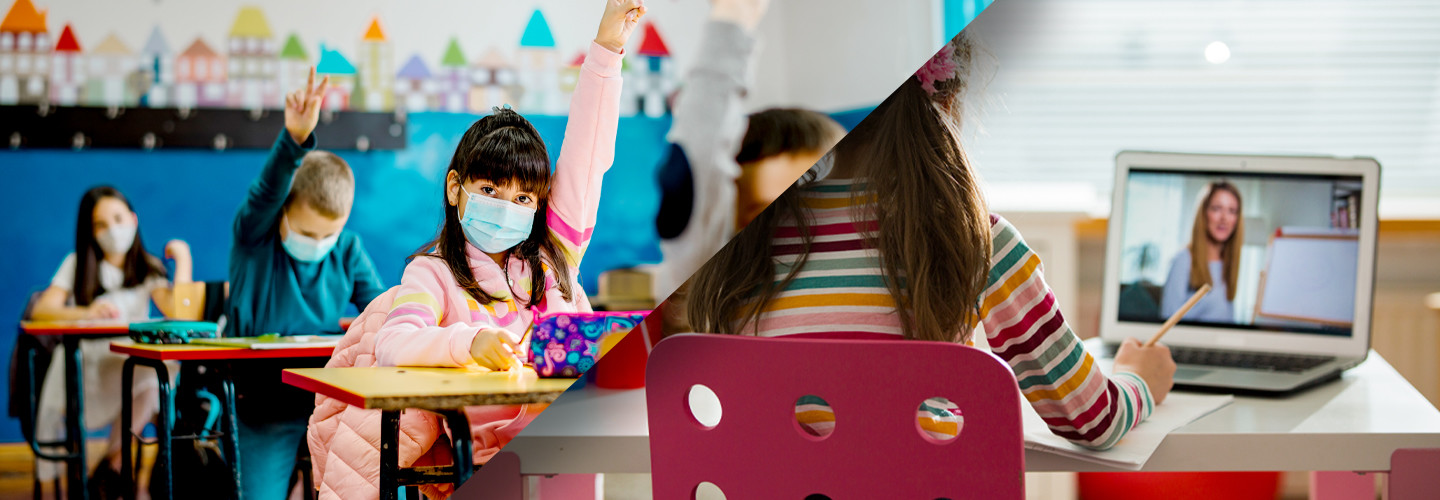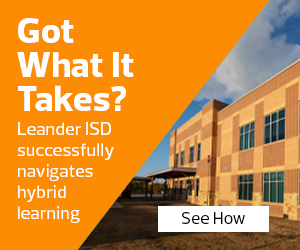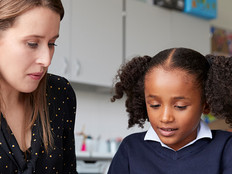What Are the Biggest Concerns About Hybrid Learning?
Effectiveness takes the top spot for digital learning concerns: Is the hybrid classroom working as intended, or is it failing students and educators in some critical way?
Hybrid learning model uptake is substantial — a recent Education Week survey found that more than two-thirds of school districts have deployed hybrid models to help provide instruction during the pandemic and reduce the risk to students and staff.
But rapid uptake doesn’t guarantee positive outcomes, and concerns remain about the long-term impact of hybrid learning on information retention, classroom engagement and student success: Will skills and knowledge gleaned during digital classes persist when schools reopen fully? Or will hybrid learners find themselves behind the educational curve?
Concerns are also emerging about the broader impact of hybrid learning. As noted by the EdWeek survey, 34 percent of school districts have opted for an either/or model — kids are either 100 percent at home or 100 percent in-person for the current term. Another 20 percent have implemented rotating schedules that see students coming and going from school at regular intervals. In both cases, however, this leaves full-time working parents wanting for steady childcare, even as students are stuck in a continually changing classroom.
DIVE DEEPER: What role will hybrid learning play in K–12?
What Are the Challenges with Online Learning?
Two common challenges must be addressed in online learning environments: concentration and comfort.
Concentration speaks to the ability of students to stay focused and complete tasks without errors. Absent the in situ environment of classrooms, however, this becomes challenging: Students will engage with screens and software only for so long. According to recent research, a student’s grade level has a significant impact on attention span — older children are better able to concentrate for longer periods of time. Younger students, meanwhile, often struggle to stay focused.
To address this issue, some states have implemented guidelines around maximum remote teaching times. In Illinois, for example, 90 minutes per day is recommended for students in first and second grades, while Kansas suggests just 45 minutes for first-year students. New Hampshire, meanwhile, says no more than 120 minutes online, plus reading time, per day.
The takeaway? There’s no hard and fast rule for how much time online is beneficial for students — and when it crosses the tipping point to problematic.
Comfort also plays a role in effective learning. Here’s why: Compared with the standardization of classroom layouts and schedules, students at home may find themselves using tools and technologies designed for adults, and at loose ends when it comes time for breaks or recess. Creating a comfortable environment for students is critical for sustained learning success.
DISCOVER: 5 tips for an effective hybrid instruction experience.
Hybrid Classroom Technology: What Equipment Is Needed for Effective Online Learning?
As noted above, the right technologies play a pivotal role in hybrid learning success. Effective hybrid classrooms, therefore, must contain components such as:
- Videoconferencing and collaboration tools: Robust and reliable videoconferencing tools are critical for driving sustained student success. Students and teachers must be able to connect easily, clearly hear and see each other and interact intuitively.
- Learning management systems: LMSs empower teachers to create lessons and monitor progress and make it easy for students to find and complete assigned work. The ideal LMS is easy to install, simple to use and naturally secure.
- High-quality cameras: Video tools aren’t enough in isolation; students and teachers also need high-quality cameras that include features such as automatic lighting adjustment and the ability to create preset camera angles. This allows teachers to easily move around their home or classroom without interrupting their lesson to adjust the camera focus.
- Kid-friendly peripherals: From kid-sized mice and keyboards to headsets that offer protection against high-decibel sounds, the right peripherals can boost a student’s comfort and make it easier to concentrate.
Which Companies Are at the Forefront of Hybrid Learning?
The pandemic came with unprecedented opportunity for advancement in digital learning solutions. And while the market continues to diversify, companies at the forefront of their respective educational verticals include:
- Google: Google Chromebooks have become the de facto classroom device for many schools, offering a low-cost entry point for students to connect with teachers every day.
- Logitech: Logitech is in the vanguard of companion technology development with a host of mice, keyboards, headsets and cameras designed to meet the needs of students and teachers alike.
- Cisco: Cisco has emerged as a leader in the videoconferencing space with its Webex solution, which makes it easy for students and teachers to connect anywhere, anytime.
- Lenovo: Classroom management solutions such as Lenovo’s LanSchool help streamline the process of student management and monitoring to ensure they’re staying on task and remaining within a secure educational environment.
Hybrid Learning vs. Blended Learning: Understanding the Future of the Online Classroom
While hybrid and blended learning environments share digital characteristics, these approaches aren’t identical. “Hybrid learning uses online components for teaching and learning that replace face-to-face classroom time,” notes Verjeana McCotter-Jacobs, chief transformation officer for the National School Boards Association. Blended learning, meanwhile, “is about providing online materials that supplement learning rather than replacing the face-to-face experience.”
With current pandemic pressures likely to become sustained, endemic stressors over time, blended learning frameworks offer a path forward for K–12 schools as 2021 continues. By leveraging the new technology, tools and infrastructure developed by companies during initial pandemic shutdowns, schools have the opportunity to empower student engagement in the classroom and more easily shift to online operations in response to changing conditions.
The shift to hybrid learning comes with questions — and even after a year, schools don’t have all the answers. Armed with the right tools and technologies, however, teachers are now better equipped to cultivate student interest, keep kids engaged and streamline the shift to blended learning environments.
MORE ON EDTECH: Learn how librarians adjusted to remote learning.










